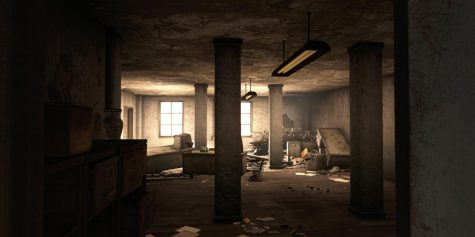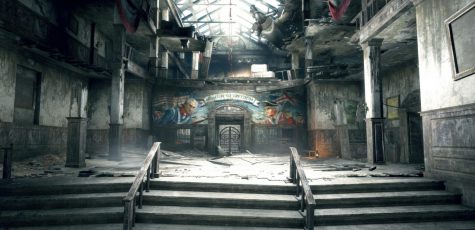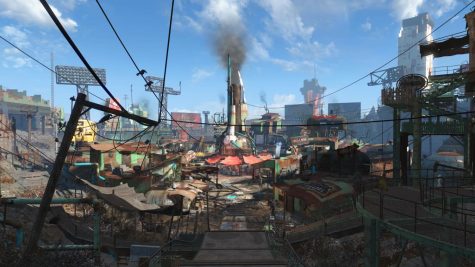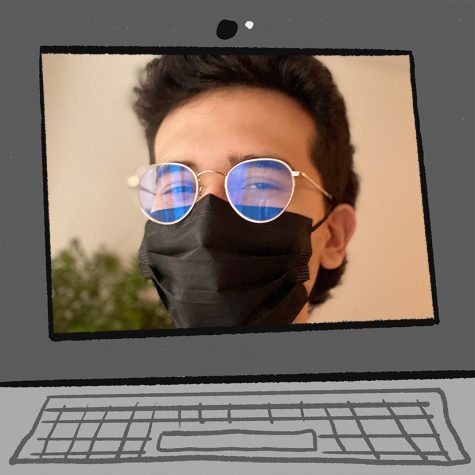Former Bethesda lead artist discusses working on ‘Skyrim’ and the ‘Fallout’ series
Having worked at the studio for over 14 years, Nate Purkeypile reflects on his time designing some of the most beloved RPGs of all time.
Former Bethesda lead artist Nathan Purkeypile spoke to WSN on working on “Skyrim” and the “Fallout” series. With over 14 years of experience, Purkeypile has a long established a name for himself. (Image courtesy of Nathan Purkeypile)
April 29, 2021
Among my friends and I growing up, there was one name synonymous with incredible video games: Bethesda. I remember graduating from a Nintendo-fueled childhood when I bought my first copy of “Skyrim” at age 12. From the moment I started the game, it was not the abundance of lore, quests or bugs that made everything in Tamriel — the game’s world — so fascinating, but the way everything looked.
From distant fjords to murky dungeons, the entirety of the game felt so tangible. I would often just listen to music and explore every corner of “Skyrim.” When I moved on to the more mature “Fallout” series, I found myself doing the exact same thing. I had no idea that there was an entire group of artists employing technical and aesthetic skill in order to create these artificial realities, nor how they went about immersing players like myself. I would eventually meet one of them: Nate Purkeypile.
Purkeypile joined Bethesda in 2006 after his time at Terminal Reality (known for games like “BloodRayne” and “Ghostbusters”) and served as an environmental artist on “Skyrim,” “Fallout 3” and “Fallout 4.” During this time, he designed iconic areas like Little Lamplight, a subterranean village inhabited only by children, to Diamond City, a settlement built in the ruins of Fenway Park. In 2017, he served as the lead artist for “Fallout 76” as well as the lead lighting designer for the highly anticipated “Starfield.” After working with the studio for more than 14 years, Purkeypile left Bethesda this year to pursue other opportunities.
I spoke with Purkeypile over Zoom on April 22. Soft-spoken and meticulous with his word choice (so as not to reveal any company secrets), he brightly reminisced about his time at Bethesda Softworks while his cat meandered around his apartment.

Nathan Chizen: So did you always want to work in video games then? Or was it just something that just happened?
Nate Purkeypile: Yeah, I pretty much wanted to do it since the third grade. I would be sitting in the back of class programming games on Apple II computers. I’m not sure why they let me do that, honestly, but I guess that worked out.
N.C: I went to Catholic school, and they got mad because I figured out how to get the computers to play “Doom,” so was it kind of like that?
N.P: That pretty much happened to me! I installed “Doom” at my Catholic school also.
N.C: (laughing) It’s a quintessential moment for game devs. Now, Bethesda is perhaps the most iconic game studio when it comes to contemporary role-playing games. How did you get started there?
N.P: So I started at Terminal Reality and I had some friends from there that eventually ended up with us at Bethesda eventually. And like everyone from that company ended up everywhere in the games industry, whether it was Bungie or other big studios. It’s like sort of this incubator for awesome game devs (developers) even though the games we made were just like, okay and did well. So I think there were already three people at Bethesda from there at the time when I joined. Now there’re so many ex-Terminal Reality people there to the point where we even have our own Slack channel.
N.C: What was your first real gig then?
N.P: I worked on “Fallout 3” first. So I did cave kits and designed Little Lamplight, plus similar locations as well.

N.C: With Little Lamplight then, how did you go about making that environment?
N.P: I did pretty much all of it on that one. The design team had a list of the characters they wanted and features, but then I figured out how I wanted that laid out. I actually wanted it to look different from the rest of the game. But since I did the cave kit, I just expanded upon it and then added some extra special pieces just for that place.
N.C: So when you do that, do you have anything specific in mind? Or are you just going off of concept art and other people’s ideas?
N.P: It depends on what it is. Sometimes we’ll have concept art and it’ll be something to build off of, but often we just have to wing it and sort of bash references together. But the concept art is disconnected from the design to some extent. So for Little Lamplight, we had concepts, but it was very different from what we actually made. So concepts end up as more of a tone setting thing as opposed to what you actually end up seeing in the game.
N.C: Were there any other locations that you designed yourself?
N.P: Yeah, I did Tenpenny Tower, and a whole bunch of random smaller places like Paradise Falls. That was fun, because you get to design it as a combat space as well as a city, depending on how you play.

N.C: What was the process for “Fallout 76” like? Did you go to West Virginia or something to like that to scope out locations?
N.P: We actually took a research trip just like we did for “Fallout 4” to West Virginia and took tons and tons of pictures! Since we did the whole state in the game, we actually couldn’t do all of it, so we just had to cherry-pick the best spots that we could do in the shortest amount of time. So it was kind of a whirlwind trip but we hit a lot of big spots.
N.C: Did you end up having any favorite locations?
N.P: Actually, it was really cool because in West Virginia they have this tour where you can go into an abandoned mine. It’s led by this old miner talking about how his friends would have black lung and all the other crazy experiences there, but it was really fun. The lunatic asylum was also pretty cool. Oh, that’s what they actually call it. Like, that’s not me being politically incorrect. It was the Trans-Allegheny Lunatic Asylum.
N.C: Oh my god. So “Fallout 76” has the biggest world, right?
N.P: Yeah, Skyrim is about as wide as it but it’s taller. So basically, yes, it is the biggest. That’s something that I fought for pretty hard for.
N.C: Really?
N.P: Yeah. I mean, it’s a hard argument to win, being like, “Hey, you know this is going to be four times bigger than Fallout 4 and even bigger than Skyrim.” And they would be like, “Are you sure you need that?” But, you know, we wanted to have that sense of really exploring the wilderness and stuff like that. It’s hard to do that if it’s too compact, and we were trying to have the whole state and it’s going to be this online game that people are gonna be playing for years. So it’s nice to have some breathing room space-wise.
N.C: How do you go about creating a combat space?
N.P: You think about where you can take cover and stuff like that. So you’re not getting overwhelmed and things? But also just making it accessible and easy to navigate.
N.C: I see. What about larger spaces? I read that you designed Diamond City for “Fallout 4.”
N.P: Yeah! I put in that random single red chair and I know all these obscure facts about that stadium now. We went there and to Boston to scout out locations and took tons of pictures. My friends that we were visiting didn’t catch on, which is kind of funny because like, I’m totally not into baseball.
N.C: So when you make these iconic spots, do you take perspective into account? Like if you stand in a certain location it ends up having a certain view?
N.P: Yeah, definitely. I mean, you can’t control every view, but like with Diamond City, that initial view when you’re coming down? Yeah. The way the power lines lead into the city, it’s all supposed to like lead your eye to the center. So I built a lot of that city around that initial view to hopefully, you know, be appealing but also show where everything is.
N.C: I see. With the much broader color palette of “Fallout 4,” was that intentional or was it more of an organic development?
N.P: It was actually the initial pitch to help differentiate it from “3” since it’s very monochromatic. So we wanted to try something different than its predecessor. There are specific colors that we had as accent colors on “Fallout 4” just like its predecessor. There’s a very particular red and blue in that game where it’s slightly more orangish-red and stuff like that, so we had swatches of them in every texture we’d make. So those colors are sort of echoed throughout the game.
N.C: I guess “Fallout 4” was the first next-gen Bethesda game at the time. Were there any challenges? Anything different going on?
N.P: Yeah, the really big one was the way the lighting works because Skyrim was what they call a forward rendering game. So basically, I could only put a few lights around things, which were accents, it’s just torches and stuff like that. But in Fallout 4, it was all deferred rendering, which let me put hundreds of lights. So in most games, you would like, you know, shine a light at the floor with light maps or something. But we just did it by hand in this game, which has a ton of work, but it also lets you control exactly how a scene looks. Yeah, so it’s a nice amount of control. And so that was a huge win. And that was definitely the big challenge in that game.

N.C: How did you become a lead artist on “Fallout 76” then?
N.P: Well, first I was the lead artist on the “Point Lookout” DLC for “Fallout 3,” so I think that eventually ended up leading towards “Fallout 76.” But I just expressed interest in doing it and was really proactive about lots of things like pointing out design issues, playtesting a whole bunch, trying to promote various features and advocating for the art team.

N.C: Since it [Fallout 76] is an ongoing, live game are you still art leading? Or have you stepped down since you left Bethesda?
N.P: Yeah, I was for about a year or so after launch. And then, towards the beginning of last year, I moved over to “Starfield.” But until the Wastelanders DLC, I was the lead artist.
N.C: What did you do overall, then?
N.P: I lit all the exterior locations and directed the art team. I was deciding what kind of stuff we wanted to add, like new creatures and weapons and things like that.
N.C: How much say did you have on what went into the game then, like when people aren’t running big creatures and items and all that stuff by you?
N.P: It seemed like the design team actually didn’t have ideas on what they wanted for that stuff. So like, I would just pitch stuff and be like, “Hey, these are the monsters we want.” They’re like “that sounds great.” And then they would figure out how that can be used after the fact. And I think part of that is also I was in a lot of those meetings where we discussed what we wanted to do design-wise, so I wasn’t just concentrating on the art. Since I had done that on the main game, making the list of all the new things we wanted in 76, that just sort of rolled forward from there to the Wastelanders content.
N.C: What kind of ideas did you have then?
N.P: Well, like on the Wastelanders DLC, I wanted a whole new series of weapons. So it’s not just other random, you know, melee weapons like shovels and things like that, like a whole ‘nother tier of weaponry. Really cool. So that’s all the high end stuff. Whereas a lot of the stuff in the base of “76” was about fleshing out just different play styles. We were making sure we had enough pistols and rifles, things like that. We added the pump shotgun, which wasn’t a thing at all, and like everything it needed coding support.
N.C: Ah ok. What about the tambourine? I loved it.
N.P: I’m glad you liked that since that was my weird side project, but I just checked into the game actually myself. We had these game jams every once in a while, and I did one called “the instruments of death.” Because I just thought it was like stupid and funny, but then I just checked it into “76” and then the sound guy saw it he’s like, okay, yeah, that makes sense for that. So he got his tambourine and made the sounds, and then the design team put it in and gave it stats and that’s it.
This interview has been edited for clarity and concision.
Email Nathan Chizen at [email protected].




























































































































































